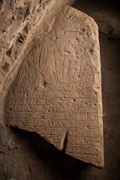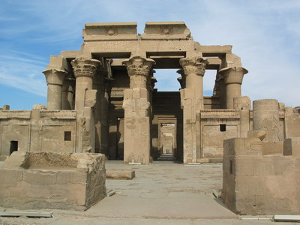|
Sandstone Pharaoh Paintings Found at Kom Ombo Temple
October 1, 2018
An archaeological team who set out to reduce the groundwater level at a famed Aswan temple is continuing to discover new (old) things. The team at the famed KomOmbo temple most recently turned up two ancient sandstone paintings belonging to two different ancient kings, according to Mostafa Waziri, head of the Supreme Council of Antiquities. One of the paintings mentions King Seti I, the 19th dynasty king who fought several wars during his time on the throne, in the 13th Century B.C. He won a significant victory over the Hittites at the Syrian town of Kadesh. He was also the father of the famous Ramses II. In the painting, the king stands in front of the god Horus and the goddess Sobek, as a winged sun shines overhead. The text below is 26 lines of hieroglyphs, which mention another king, Horemheb, more than once. The archaeologists found that painting in two parts but also found that the inscriptions were legible. The other painting mentions Ptolemy IV, also known as Philopator, who ruled in the 3rd Century B.C. He defeated the Seleucid Empire at the Battle of Raphia, one of the largest battles in ancient times. He is also believed to have commissioned the creation of the tessarakonteres, thought to have been the largest ship ever constructed. The painting, which was found in several parts and restored by the archaeologists, shows that king standing and holding a stick with one end in the form of the god Horus, while his wife Arsinoe III stands beside him. Hieroglyphs numbering 28 lines stretch beneath that image. The paintings constitute the second recent find at KomOmbo. In September, archaeologists found a sandstone sphinx that also dated to the Ptolemaic era. The Temple of Kom Ombo is rather unusual in that it was dedicated to two gods. In effect, it is a complex consisting of two parallel temples. The northern half of the Greco-Roman temple was dedicated to the falcon god Horus; the southern half was dedicated to the crododile god Sobek. Among the engravings inside the temple are what are thought to be the first known Egyptian depiction of medical instruments. Horus was also believed to be a doctor. Construction on the temple begin in the 4th Century B.C. and continued for decades thereafter. The temple, famous for its crocodile statues, is near a small Nile River town of the same name, about 45 kilometers (27 miles) north of Aswan and about 800 kilometers (497 miles) south of Cairo. Archaeologists in April 2018 found a bust of the Roman emperor Marcus Aurelius there. |
Social Studies for Kids |
Social Studies for Kids
copyright 2002–2019
David White







